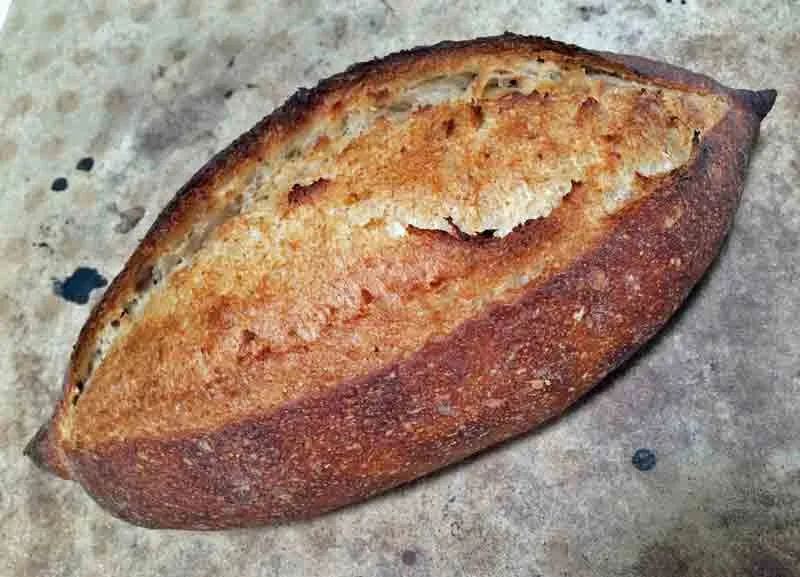
San Joaquin Sourdough Two Ways
David Snyder
September 28 and October 2, 2017
Background
My San Joaquin Sourdough originated in Anis Bouabsa's baguettes which had won the prize for the best baguette in Paris in 2008. Bouabsa's baguettes departed from convention in utilizing a 21 hour retardation after bulk fermentation and before dividing and shaping. Jane Stewart (Janedo on TFL) and I initially modified Bouabsa's formula by adding a bit of rye flour and some sourdough starter for flavor. I then omitted the commercial yeast altogether and began using the modified formula to shape as bâtards. Over time, I have tweaked the formula and method in various ways, but have settled on the current one as providing the best product.
I most often make my San Joaquin Sourdough as bâtards of about 490 g, but I have used the same dough for baguettes quite often. I have also modified the formula in minor ways to make an “Italian bread,” and have used it for pizza too.
This week, I made two batches of San Joaquin Sourdough. One I used for bâtards. The other I made as “pains rustiques.”
Professor Raymond Calvel, the renowned French baking teacher and bread scientist, was the man who taught Julia Child to bake “French Bread,” the author of “Le Gout du Pain” and the inventor of the autolyse. Shortly before his passing in 2005, Professor Calvel visited the United States and taught at the Culinary Institute of America in upstate New York. The C.I.A. and the Bread Baker's Guild of America produced a series of videos which included interviews with Professor Calvel and documentation of his baguette formula and methods. These were available for downloading and also as VHS tapes at one time. Now, they are available on youtube. They are well-worth viewing for any serious baker.
On one of the tapes, almost as an aside, the narrator said Professor Calvel's personal favorite bread was what he called “Pain Rustique.” He made this with baguette dough, but, rather than shaping it in the traditional manner, the dough is simply cut into rectangular pieces with a bench knife, proofed and baked. I made this bread once a number of years ago, and it was very nice. It was similar to ciabatta in that it was very puffy with large air pockets.
Today, I made a variation on pain rustique, using San Joaquin Sourdough dough and methods, except for the shaping. Note: The formula used for these pains rustique was actually only 72% hydration. Based on my results, I would increase the hydration to 76% hydration (as in the formula below) or even higher for my next bake of this bread.
Formula
Total ingredients | Wt (g) | Bakers % |
AP Flour | 479 | 89 |
WW Flour | 33 | 6 |
Medium rye Flour | 29 | 5 |
Water | 412 | 76 |
Salt | 10 | 1.8 |
Liquid starter | 17 | 3 |
Total | 990 | 180.8 |
9.2% of the flour is pre-fermented
Liquid Levain ingredients | Wt (g) | Bakers % |
AP Flour | 29 | 70 |
WW Flour | 8 | 20 |
Medium rye Flour | 4 | 10 |
Water | 42 | 100 |
Liquid starter | 17 | 40 |
Total | 100 | 240 |
1. Mix the levain by dissolving the liquid starter in the water, then add the flours and mix well.
2. Ferment at room temperature, covered tightly, until the surface is bubbly and wrinkled. (8-12 hours)
Final dough ingredients | Wt (g) |
AP Flour | 450 |
WW Flour | 25 |
Medium rye Flour | 25 |
Water | 370 |
Salt | 10 |
Liquid levain | 100 |
Total | 990 |
Method
Dissolve the levain in the water, add the flours and mix to a shaggy mass. Cover and autolyse for 30 minutes.
Add the salt and mix to incorporate.
Transfer to a clean, lightly oiled bowl and cover tightly.
Bulk ferment for 3-4 hours with stretch and folds in the bowl every 30 minutes for the first 2 hours, then a stretch and fold on the board after 2.5 hours. The dough should have expanded by about 50% and be full of small bubbles.
Refrigerate the dough for 18-24 hours.
Take the dough out of the refrigerator and transfer it to a lightly floured board.
For Pains Rustiques
Divide the dough into 6 equal pieces and pre-shape as logs or round.
Cover the pieces and allow them to rest for 60 minutes.
Stretch each piece to a rectangle 8-12 inches long, depending on the weight of each piece.
Proof for 45 minutes, covered.
Pre-heat the oven to 500ºF with a baking stone and steaming apparatus in place.
Transfer the loaves to your peel. Turn down the oven to 480ºF. Score the loaves, if desired, and load them onto your baking stone.
Bake with steam for 10 minutes, then remove your steaming apparatus and continue to bake for another 10-12 minutes.
Remove the loaves to a cooling rack, and cool for at least 30 minutes before serving.
For Bâtards
Divide the dough into two equal pieces.
Pre-shape as rounds, cover and let rest for 1 hour.
Shape as bâtards.
Proof on linen or parchment, smooth side down for 45 minutes.
Pre-heat oven to 500ºF with baking stone and steaming apparatus in place.
Turn down oven to 460ºF.
Transfer loaves to peel.
Steam oven and transfer loaves to th baking stone.
After 12 minutes, remove steaming apparatus.
(If you have a convection oven, turn switch to convection bake and turn the temperature down to 435ºF). Bake for 18 minutes more in a dry oven.
Transfer loaves to a cooling rack and let cool thoroughly before slicing.
Photo Gallery
San Joaquin Sourdough Pain Rustique
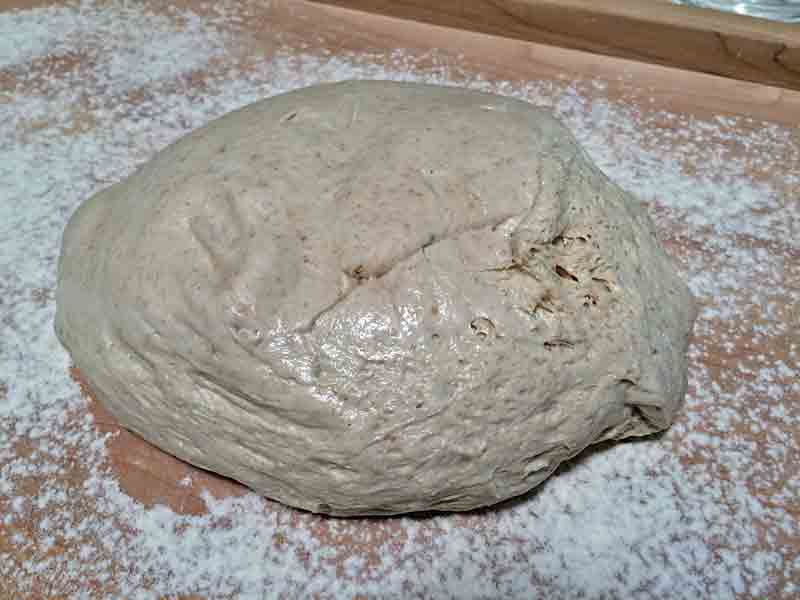
SJSD dough, fully fermented and ready to divide
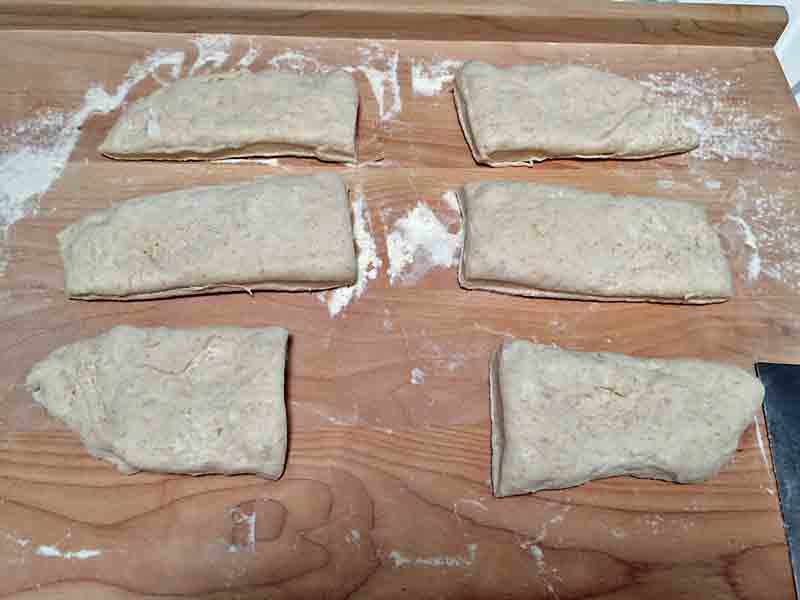
Dough divided for Pains Rustiques
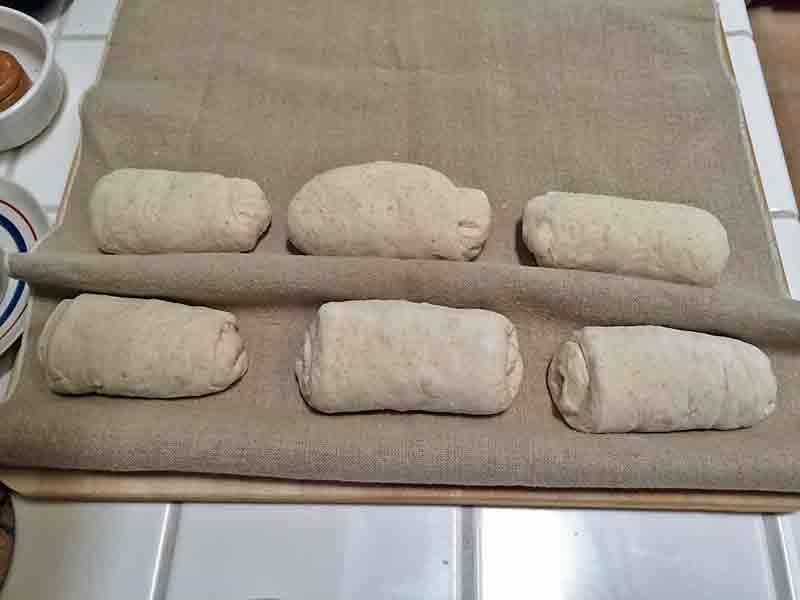
Pre-shaped
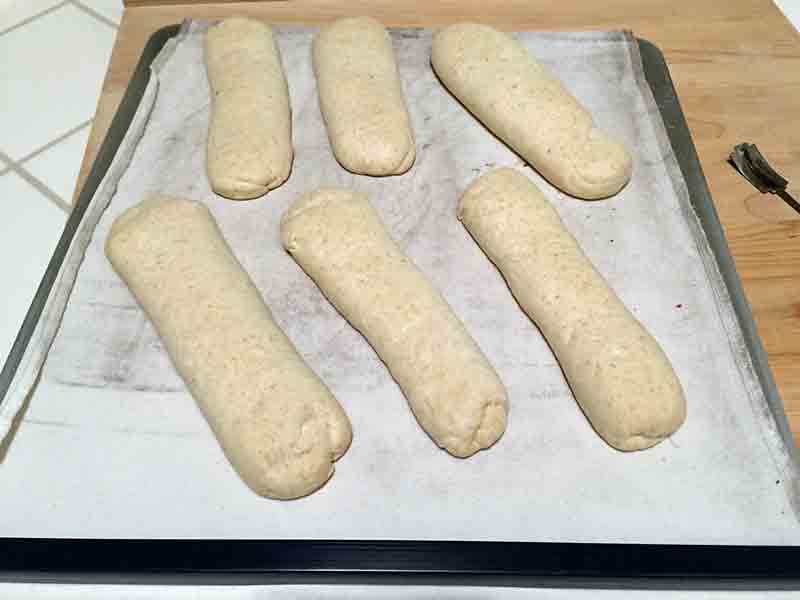
Shaped and proofed, ready to bake
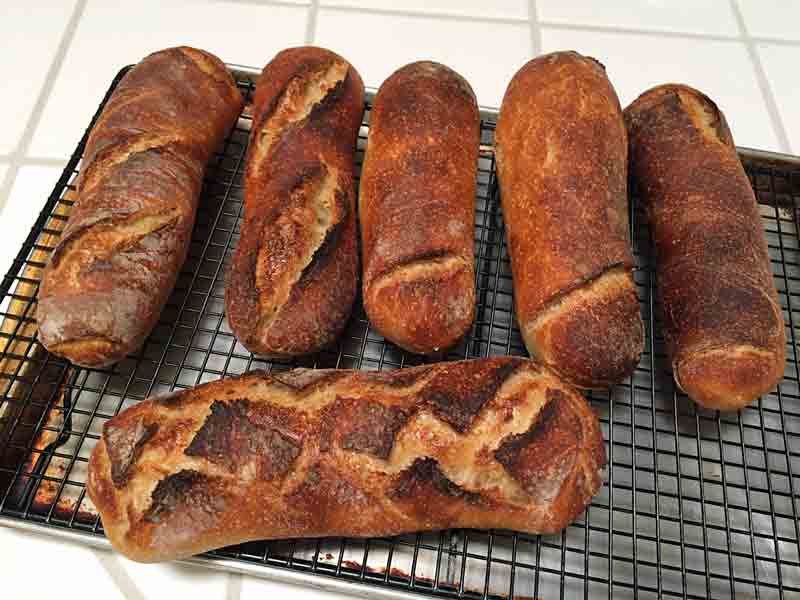
SJSD Pains Rustique - some unscored, others scored in various ways.
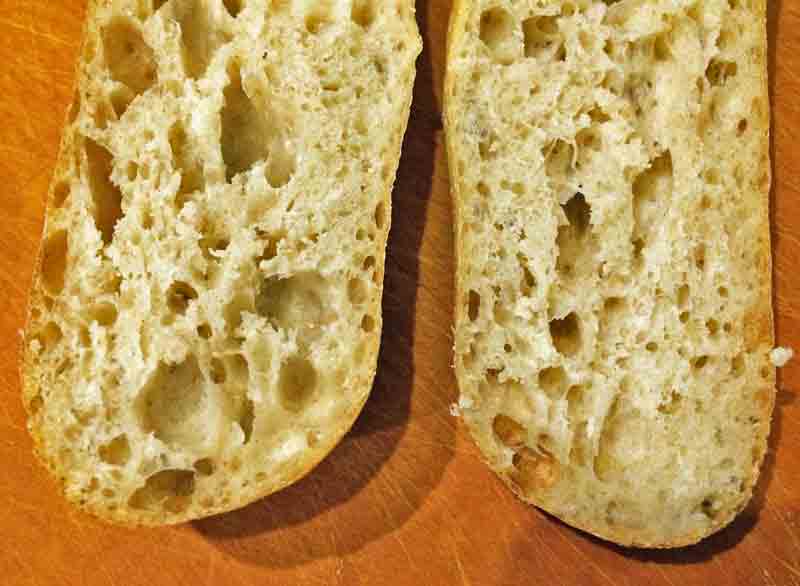
San Joaquin Sourdough Pain Rustique crumb
San Joaquin Sourdough Bâtards
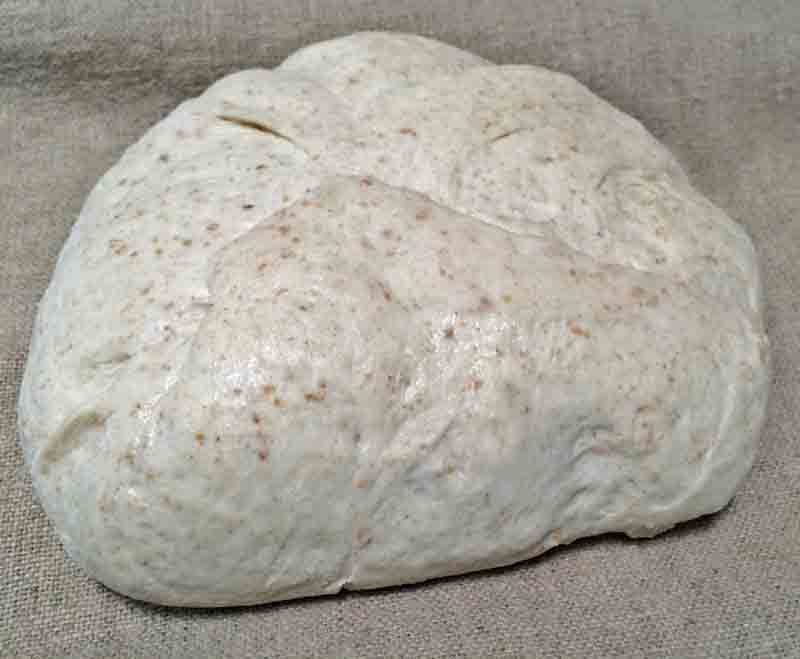
Pre-shaped piece
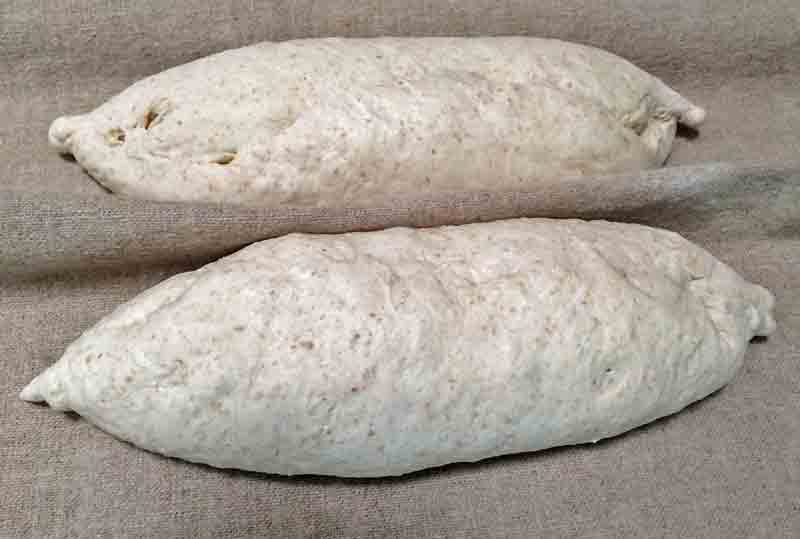
Shaped loaves proofing
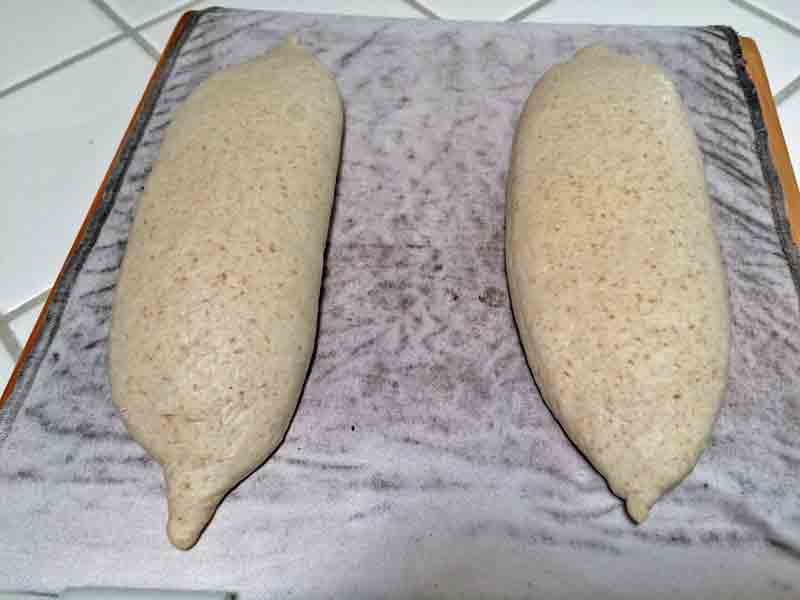
Loaves proofed and ready to bake
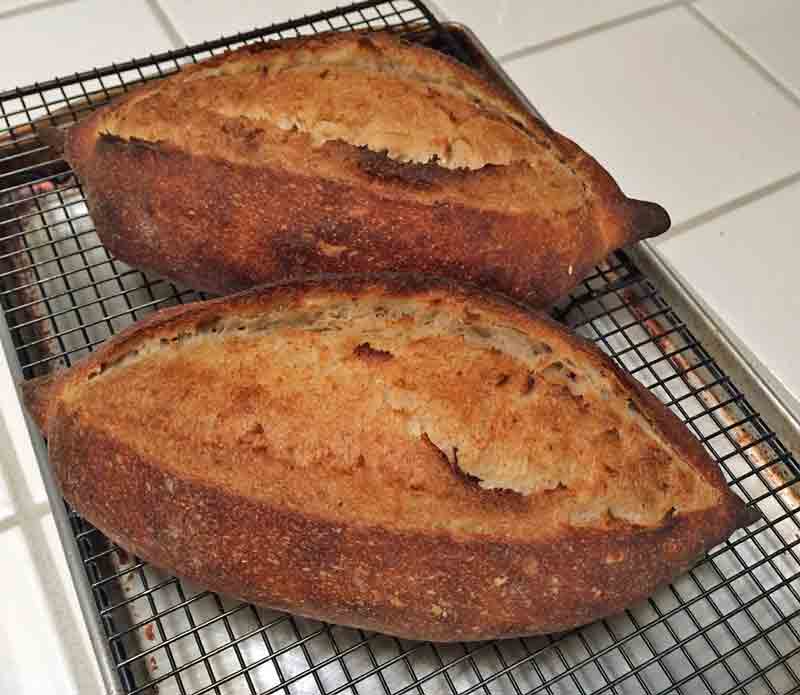
San Joaquin Sourdough Bâtards
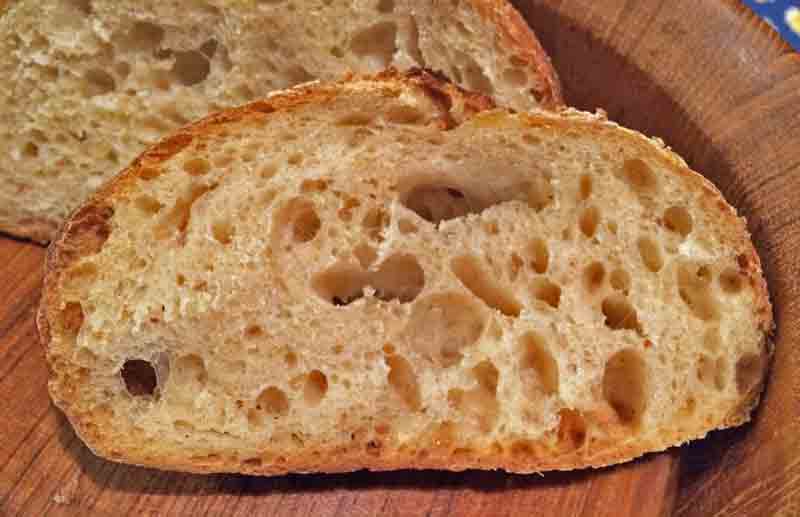
San Joaquin Sourdough Crumb
Enjoy!
David
- dmsnyder's Blog
- Log in or register to post comments
is exquisite!
I'm so grateful that you posted your current formula, and it is now safely bookmarked. This is definitely high on my list of your lovely formulas for me to try.
Thanks so much for so generously sharing your experience and knowledge --- and temptations!
All the best, and keep baking happy!
Nice experiment with different outcomes from the same dough, David. The crust looks lovely.
I may have missed it, but those 'Rustiques' look like the proper weight for some chewy sandwich rolls! Delicious!
Glad to see you are still happily baking.
-Arlo
They are just right for sandwiches with your choice of sausages, cut it half the long way.
Actually, the rolls are just enough too long to leave a few slices for delicious French toast.
David
David - thanks for this approach to San Joaquin sourdough. I'll try this for a future bake. Normally my SJSD breads only use 10% Rye flour and no whole wheat. What brand of 'medium' rye do you use? Normally I use Bob's Red Mill Dark Rye; is this too strong? A question - you mention the levain build with a "liquid starter." Is this just a 100% AP starter or something else. Also, in the batard section for those with convection ovens, you say "...turn down on the fan..." Should not that just be "...turn on the fan..." or the convection feature. My KitchenAid oven one has to turn on the convection and adjust the temperature with one switch.
Great pictures and inspiration.
My current flour mix is the result of many trials of differing proportions of AP, rye and WW. I like this one best, YMMV, of course.
These batches used home-milled WW and Rye in one and home-milled WW and KAF medium rye in the other. I have used BRM Dark Rye in SJSD in the past. No problem.
My usual liquid starter is 100% hydration. The flour used is a mix of 70% AP, 20% WW and 10% whole rye.
I have a KitchenAid convection oven too, but it does not automatically adjust the temperature as far as I know. It's 21 years old. I see what confused you. I inadvertently type an extra "down" in that sentence. Thanks for calling it to my attention. I'll correct it.
David
to make the bread. Thanks so much for the history and exacting writeup on the San Joaquin sourdough two ways. I'd give them a try – mostly the methodology of retard before sharping and the longer bake than I usually do. You have given me motivation to explore this well-known bread and the formula to reproduce it. I won't miss playing around with it.
Shirley
What Beauties! That's all. Stunning!
Hester
and I can almost taste how yummy they are! Great job!
Baked it and very happy with the results. I need more practice and this formula is a versatile platform.
I've wanted but never gotten around to making San Jaoquin sourdough (I grew up in the San Jaoquin Valley), so I'm very glad you posted your current formula! I've been doing a lot of porridge breads and breads with soakers, and my shaking skills definitely are rusty. I'm looking forward to making this loaf again soon, improving on the shaping and probably the fermentation times. It's always so hard to time the bakes well on work days.
I really did grow up there... Not sure why I'm having a hard time posting images, I had included one in my post. Here's a link to a photo of my loaf: https://www.instagram.com/p/Baw-33QlQWJ/?taken-by=inthewildlight
The linstagram link goes to a loaf with rolled oats on the crust. Is that a SJSD? I've done so many versions, but the only coating I've used was sesame seeds, as far as I can recall.
Anyway, SJSD is somewhat like the old Levy's Rye Bread ad. You know, "You don't have to be Jewish to like" it. (The fact is anyone who really likes Jewish Sour Rye would turn up his/her nose at Levy's. )
There is nothing intrinsically "San Joaquin" about SJSD, except that's where I grew up and live (again). Hope you enjoy it!
David
David, thanks for the reply! Yes, the instagram link goes to the SJ loaf. I threw some oats in the bottom of the banneton while waiting for the oven to warm - I didn't give it much thought, but it tastes great! I'll have to try sesame seeds.
Ha, it is a very easy loaf to like. I'll be baking a second tomorrow.
In the process of making this loaf, I thought a lot about Turlock and my family, so for me it's deeply connected to my life in the valley. Enjoy it for me, I always loved fall there!
Lauren
Mr. Snyder, thank you for your detailed recipes and instructions and, for your thoughtful discussions. I have previously benefited from your posts but to my chagrin, just now posting my belated thanks.
This will be my next bake.
Howard
Let us know how the SJSD works for you.
Happy baking!
David
David, a quick note of thanks!
Just thought you'd like to know that your method, basic ratio, and timing have become more or less the starting place for all my sourdough. I've been experimenting with more/less rye, adding an overnight (commercial yeast) poolish in addition to the leaven, using some corn flour to add some unique tasting notes, and a few other changes. But I keep coming back to this as a jumping off point. Thank you, for creating such an easy, reliable, tangy, and delicious recipe.
My latest, slightly bean-shaped, beauty is below. Came out of the oven this morning. Great, open crumb, very sour, and the crust is exceptionally crusty -- all this even with a gas oven. The crust broke in two places outside my score lines, but that's unusual for this dough in my experience.
Leaven: 35g starter, 60g AP, 17g WW, 8g dark rye, 86g water
Final Dough: 205g leaven, 575g Guisto's AP, 400g Bob's Whole Wheat, 25g dark rye, 10g malt powder, 800g water, 25g salt
Baked 20 min covered at 500 dF, 21 min uncovered with convection at 450 dF.
Your loaf looks great.
I'm happy the sjsd has helped your baking journey!
David